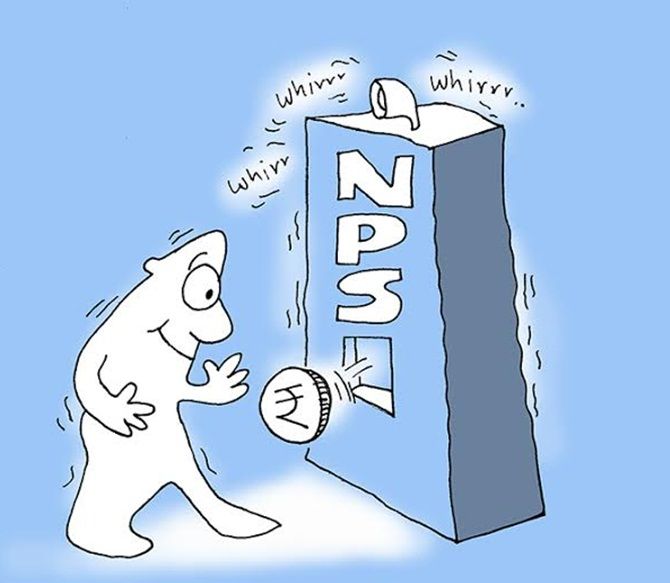Restrict investment to Rs 50,000 for tax benefits, experts tell Sanjay Kumar Singh, but caution that taxation at maturity and compulsory annuities are dampers.

Illustration: Uttam Ghosh/Rediff.com
As the National Pension System (NPS) celebrated its ninth anniversary on May 1, the glass continues to remain half full for investors.
While the returns from NPS funds over the past year have been sound, and many investor-friendly changes to norms were announced by the regulator, the costs associated with NPS have moved up for what was originally envisaged as a low-cost product.
Taxation on maturity and compulsory annuitisation are other bugbears that prevent investors from investing in NPS beyond the tax deduction limit.
Sound returns
Over the past year, NPS equity schemes (E) have, on an average, done better than large-cap equity funds from mutual funds.
NPS funds (E) have given an average return of 17.68 per cent while large-cap equity mutual funds have given 12.22 per cent.
However, category E funds have lagged behind large-cap funds over the three-year (average return 7.47 per cent versus 10.24 per cent) and five-year horizons (14.68 per cent versus 15.60 per cent).
"For active fund managers, containing downside risk is a priority. Market valuations had risen very high in the past year, so many fund managers had gone into cash or placed defensive bets. NPS schemes have outperformed by staying invested in the index," says Deepesh Raghaw, founder, Personal FinancePlan.in, a Sebi-registered investment advisor.
In future, returns between equity funds of NPS and mutual funds may converge.
"As large-cap funds from mutual fund houses grow bigger, they may find it more difficult to generate alpha. The new Sebi rules regarding reclassification of schemes will also make fund managers' task harder. Large-cap funds will then increasingly invest in index stocks. NPS schemes will be at an advantage due to their low fund management charge," says Vivek Banka, founder, Alitore Capital.
At 3.25 per cent, the average return from category G (government security) funds is quite low over the past year due to the rise in the 10-year G-Sec yield by around 78 basis points.
Corporate bond funds gave a better return of 5.14 per cent over this period.
"Corporate bonds have lower duration than gilts, and hence are less susceptible to interest-rate increases," says Banka.
He adds that investors should not be guided by only the past year's returns and hence allocate more to equity and less to government security funds, but should take into account their risk appetite.
Many investor-friendly steps
The Pension Fund Regulatory and Development Authority (PFRDA) hiked the entry age into the NPS for private citizens from 60 to 65.
With better healthcare facilities, growing fitness levels, and increasing life spans, more people now work after 60, and hence can contribute to a retirement product like NPS.
The period after which investors can make a partial withdrawal from NPS for special purposes was reduced from 10 years to three.
"It makes the product more liquid. But what people can withdraw is 25 per cent of the contribution, not the corpus, so the amount they get may not be very large," says Raghaw.
PFRDA also floated a concept paper proposing to raise equity allocation under the active-choice option to 75 per cent, up from 50 per cent.
"The circular notifying it should be out within a month," says Sumit Shukla, chief executive officer, HDFC Pension Fund Management. Financial advisors regard it as a positive step.
"Depending on the response, I expect the ceiling to go up further in the next three-four years. NPS has to compete against the Employees' Provident Fund (EPF). The latter is still experimenting with a 15 per cent allocation to equities, so NPS is much ahead on the curve," says Arvind A Rao, a Sebi-registered investment advisor.
Another key proposal made in the past year was that the equity investment limit for central government employees, currently at 15 per cent, would be brought at par with private citizens.
"Final discussions are taking place, but it may take another three-six months for this to become a reality," says Shukla.
Some proposals, such as the one to allow porting from EPF to NPS, appear to have been put on the backburner.
The soon-to-be-announced policy on foreign direct investment in the pension sector and the fresh licensing of pension funds managers, this time for perpetuity, are also expected to give a fillip to the penetration of pension products.
What should investors do?
Most financial advisors suggest that investors should put money in NPS up to Rs 50,000, or up to 10 per cent of basic salary, to fully utilise the deductions available.
"We don't advise investing more in NPS due to compulsory annuitisation at maturity, as income from annuity is taxed in the hands of the retiree," says Rao.
Adds Raghaw: "Those in the 30 per cent tax bracket may invest provided they have so much savings that investing in NPS does not crowd out other investments, and if they won't need the money till retirement."
New investors should judge their risk appetite and then decide on their allocation to categories E, C and G.
Rao suggests that those up to 40 should opt for 75 per cent to E (once permitted), 15 per cent to C, and 10 per cent to G.
Those between 40 and 50 should allocate 50 per cent to E, 25 per cent to C, and 25 per cent to G, while those between 50 and 60 should allocate 30 per cent to C, 40 per cent to G, and 30 per cent to E.
Next comes the selection of a pension fund manager (PFM).
"The difference in returns of PFMs is not more than 2 to 3 percentage points. Moreover, some PFMs will do well in some years and others in other years. So make a choice based on the pedigree of their asset management businesses," says Banka.
Last year, PFRDA hiked the distribution charges. Now, Rs 0.25 per cent of contribution, subject to a minimum of Rs 20 and maximum of Rs 25,000 has to be paid to the point-of-presence (PoP) each time you invest.
"To avoid this charge, savvy investors should open an online account through e-NPS using Aadhaar," says Raghaw.










